When Steve Russell, a student at MIT, created his game Space War back in 1962, it could only play on those room-sized computers that we see in archive footage. Allegedly this is the first video game in history, and it featured combat between two space crafts drawn by simple lines. There were games like the electromechanical Nim (Nimatron) player in the 1940s, OXO in 1952, and Tennis for Two in 1958, which used an oscilloscope to define the ball's position on the screen. Still, Space War is considered the first by most. The first arcade game then, according to many, is Nolan Bushnell's creation called Computer Space from 1971. It already had a soundtrack that accompanied the battle that took place in space. It consisted of explosions, missiles firing, rocket, and thruster engines whirring. In the aftermath, Pong was released in 1972 with its beeping sounds.
When computers were initially developed, they didn't encompass producing musical sounds in the hardware, but more in a business machine fashion just processed the data. The audio qualities of the system were not a priority for the developers. These included IBM 5100, Commodore PET, Olivetti P6060, NEC PC-8001, and Apple I, which had beeper speakers or none onboard.

Apple II
Systems like Apple II from 1977 changed the game. The sound processing qualities were already quite good with the MOS Technology 6502 microprocessor and the Music Card MC16 in use. When combining two or three of these cards, the output was stereo. The default system only had a monophonic speaker. The ALF AD8 Music Synthesizer launched in 1976-77 and was a one-voice synthesizer card. By putting up to eight parallel cards, one was able to play eight simultaneous voices. It also had the Music Entry Program (ENTRY) system, a sophisticated musical notation software inbuilt. Steve Wozniak and Steve Jobs, who developed the system, said that the design was also influenced by the Atari 2600. Atari 2600, NES, Famicom, and handheld consoles like Atari Lynx used the MOS 6502 microprocessor.
From Arcade Cabinets to the Home Computer Screen
When Space Invaders was released in 1978, it was one of the first games with a background music track. Pac-Man, maybe the most famous arcade game from 1980, was the first to use a cut scene between levels. Arcade machines had their golden age from the 1970s until the early 1980s. Their contemporary and succeeding consoles also used PSGs and dedicated sound chips to generate their sounds and music. They used subtractive or analog synthesis to the production of their sounds. In this technique, the oscillator generates the waveform, which is then filtered to leave off unwanted frequencies. Then the signal is passed through an amplifier that modifies the signal's envelope and amplitude before directing it to the speakers. The tweaking possibilities were otherwise quite limited. The technology didn't allow the changing of the timbre of the instruments. They lacked expressivity but paved the way for the rise of the early sound cards and chips for computers despite that.
A company from Cambridge called Acorn had also been working on their computer design. They started with the Atom in 1981, which had 2 kilobytes (K) of memory and good gaming abilities with sound and a cassette recorder for storage and retrieval of software. An array of games like arcade classics Space Invaders and Asteroids helped the unit gain popularity in the beginning. Next year Acorn launched their BBC Microcomputer or BBC Micro, which already had 16K of RAM in the lower-end model and 32K in the higher-end one. The downside of it was a high price tag of 300-400£, but with the help from the educational minister, unit sales boomed, and it became a school computer standard in the UK. The unit had great sound and color graphics and excellent conversions of popular coin-ops in it.

Sinclair ZX Spectrum advertisement
In the early days of computing, a notable figure was a British inventor called Clive Sinclair, who started his working career selling electronics kits. His first design, the Sinclair ZX80 from 1980, was quite clumsy and limited. Still, its successors, the ZX81 and especially the Sinclair ZX Spectrum, hit the market with a boom because its higher-end model already had 48 kilobytes of RAM in it with only 175£ in Great Britain. It was a lot of memory because many of the competitors only had 16K or 32K of RAM. It had many dedicated games like Spectral Invaders, Meteor Storm, Hunchback, Chuckie Egg, Hungry Horace, and The Hobbit, which had its basis on the Tolkien tale. It was even a pretty sophisticated adventure game. Thanks to software houses like Psion, Ultimate Play The Game, and Spectrum Games, the increasing quality of the games helped the sales of the unit. But despite its low price and easy-to-access approach, it lost in the long run to its competitors like the American Commodore 64. We can see that most home computer producers were using popular coin-op games or their clones to boost the sales of their units. There was a vicious cycle on the market: the computers had to have good games to sell, and programmers would not make games for units that did not sell.
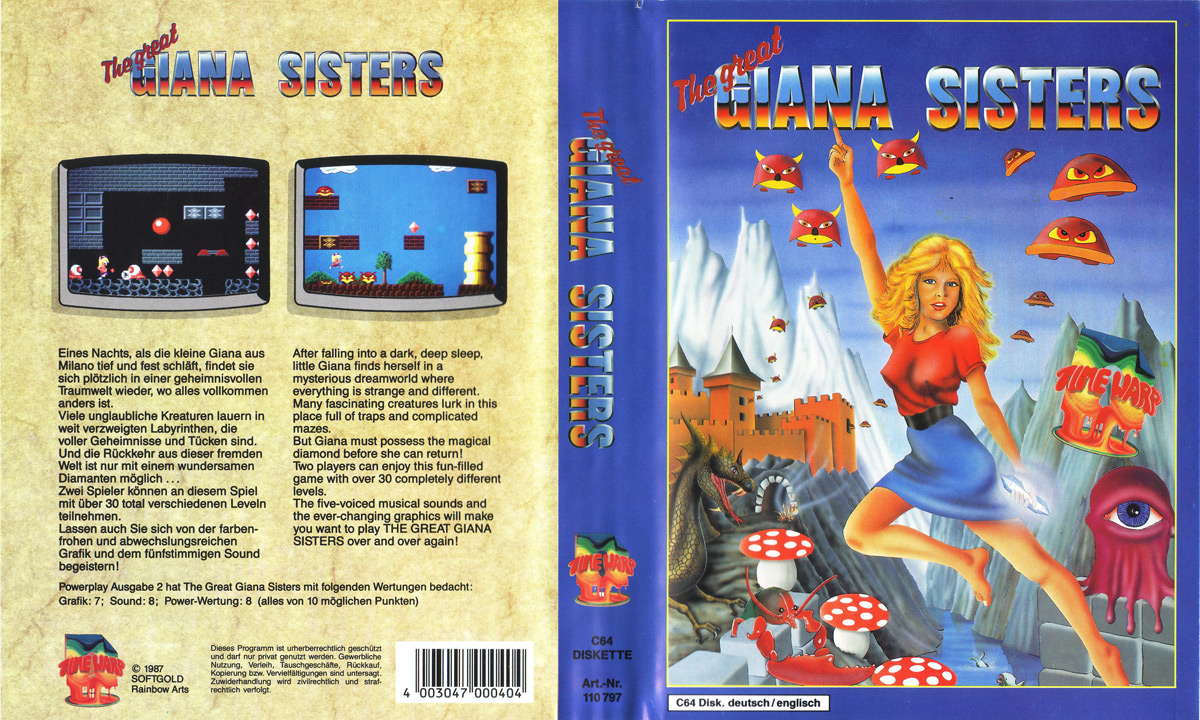
The Great Giana Sisters cover art
Commodore 64 or C64 came to the market in 1982, and its sound processing capabilities were significantly higher than that of the PCs of that time, which didn't have customized hardware. Its predecessor, VIC-20, was already a promising attempt back in 1980-81, but its successor was a giant leap forward, especially in the sound processing capabilities. The SID 6581/8580 chips offered three oscillators, four different and interchangeable waveforms, filters, including a ring modulator and an ADSR envelope. Music created with the chip was called chiptune music. Chiptune became, for a long time, the most used sound in video games. Games like Mutants, Ghouls 'N Ghosts, Mega-apocalypse, R-Type, Arkanoid, and The Great Giana Sisters displayed the sound processing qualities of the unit with their music. Hit games like International Soccer helped to boost sales. Commissioned composers like Rob Hubbard, Sid Meier, Fred Gray, Tim Follin, Matthew Kane, Chris Hülsbeck, and Martin Galway gained legendary status with their soundtracks. The designer of the SID chip, Robert Yannes, later also designed chips for Apple IIGS and his company Ensoniq. C64 washed the floor with its contemporary PCs like the IBM PC, especially in their sound delivery performance.
Let's get serious
The so-called home computer price war in the early 1980s began with two companies, namely Texas Instruments (TI) and Commodore. TI had started to sell calculators in 1983 for less than their production cost when other calculator manufacturers paid more for their mere components. Commodore wanted to keep their customers satisfied when the competition moved to the home computer market. Texas Instruments arrived first in 1979 with their Texas Instruments TI-99/4, the first home computer to have a 16-bit CPU onboard. The unit also had a speech synthesizer and was bundled with a monitor, but only 256 bytes of memory to cut the production costs. They re-modeled the computer to TI-99/4A in 1981. It had improved graphics and memory expandable up to 32K. In 1983 also Atari had joined the competition with the Atari 800 selling at 169$. When TI slashed their prices under the production costs later that year to 99$, the others answered. The Commodore 64 sold in some stores for 199$ compared to the previous 350$. Commodore had the edge on the market when it owned the MOS Technology that produced the 6502 CPU chip, which all of these companies used. Hence it survived as the winner of the war, although the aftermath was that Atari and Commodore were left financially bleeding, and TI disappeared totally from the home computer market.
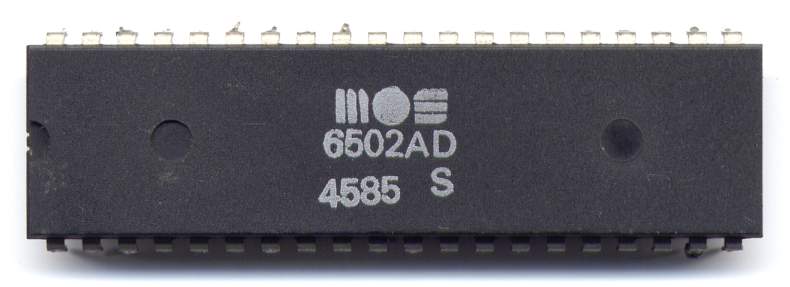
MOS 6502 AD Chip
In 1985 the Japanese computer company NEC released their PC-8001mkIISR, which was primarily meant for gamers. It had enhanced sound processing capabilities compared to its predecessor, the PC-8001. It had an FM synthesis audio system, whereas the PC-8001 only had a primitive beeper speaker onboard.
Commodore Amiga 500 (1987) further expanded the palette for the game composers. It could use four simultaneous stereo PCM samples with its Paula sampling system which allowed the import of one's samples and included the tracker software Modtracker. After this, Soundtracker 2 arrived in 1991, and it became the factory standard for a long time also for the demo scene. The program used the MOD (Module) file format. It could play four simultaneous channels of audio and fifteen different instruments. There was no need for synthesis cards because the samples were packed in files that were notably larger than MIDI files. We can hear Amiga's musical abilities in games like Commando, Shadow of the Beast, Golden Axe, Xenon, Speedball, Gods, and the Chaos Engine series. Composers like The Bitmap Brothers, You Takada, and Tamayo Kawamoto made their contributions to this system. Amiga 500 used the Motorola 68000 microprocessor, which was also in Amiga 1000 and Sharp X68000.
The Sharp X68000 (1987) was unarguably one of the most sophisticated systems at its release. It used a Yamaha's FM synthesis chip to create sound, and so did its contemporary home console Sega Mega Drive. Onboard the X68000 was the YM2151 chip used in the arcade machines of that time and represented the top of the line from Yamaha's products. However, the Mega Drive designers wanted to save on the costs and put the YM2612 instead to the console. It was a cost-reduced option that also had compromised qualities considering the delivery of the sounds. The system came with a high price tag in Japan, where it cost 369 000 yen in 1987 with its launch. This translates to 3000$ in 1987 money. Games including Akumajou Dracula aka Castlevania, Gradius 2, and Super Street Fighter II display the capability of the sophisticated sound chip that represented the summit of that time before the arrival of high-end PC sound cards.
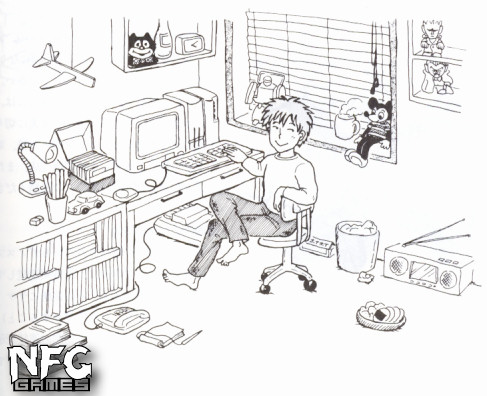
Sharp X68000 user manual illustration
The CD-ROM format was announced in 1984 and introduced in 1985. Its 650MB storage capacity allowed games to suddenly have considerably more data and naturally more complex musical arrangements in them. Synthesis, MIDI, and Redbook audio, with which one could stream digitized audio directly from the disc, meant that the music did not have any interactive properties. The disc merely played it and determined its start and endpoint, although the sizable memory amount allowed orchestrated and recorded music using a real orchestra.
The Arrival of Sound Cards
FM sound cards already became available for home computer users in the late 1980s. In 1991 they released the first commercially successful sound card Pro AudioSpectrum (PAS) 8 bit. It meant that those arcade-quality sounds became even more usable in the home computer systems. Even though this model was only a modest success, the successor Pro AudioSpectrum 16 put up serious competition against its rival, the SoundBlaster 16, which saw its release in 1992. It supported stereophonic CD-quality sound recording and playback with a bit depth of 16 bits and a sample rate of 44.1 kilohertz and was compatible with the SoundBlaster. It also had an advanced 20-voice stereo synthesizer called Yamaha YM262 (OPL3) inbuilt. It was capable of 4-operator FM synthesis and had MIDI compatibility. The improvements from both companies led to a small sound card war in the 1990s. With MIDI, only the commands were inside these files. They were minimal and left more memory space for other things. However, it became obsolete with the rise of CD-ROMs that did not rely on the sound card's synthesizing properties to generate the sounds and music.
In 1994 when mainly consoles dominated the gaming market, PC game developers wanted to stay in the competition. Games like SimCity, Colonization, Myst, Wolfenstein 3D, and Doom were released. Wolfenstein was a gory but fast processing shoot-'em-up in a maze, and Doom takes place in outer space. The soundtrack for Doom has been composed by Robert "Bobby" Prince, who also drew inspiration from Pantera and Alice in Chains. A fully three-dimensional shoot-'em-up, namely Quake, was released one year later, and it was even bloodier than Doom. Both Doom and Quake were among the first games of the genre that became popularly known as FPS or First Person Shooter. Trent Reznor from the band Nine Inch Nails made the soundtrack to the latter title.
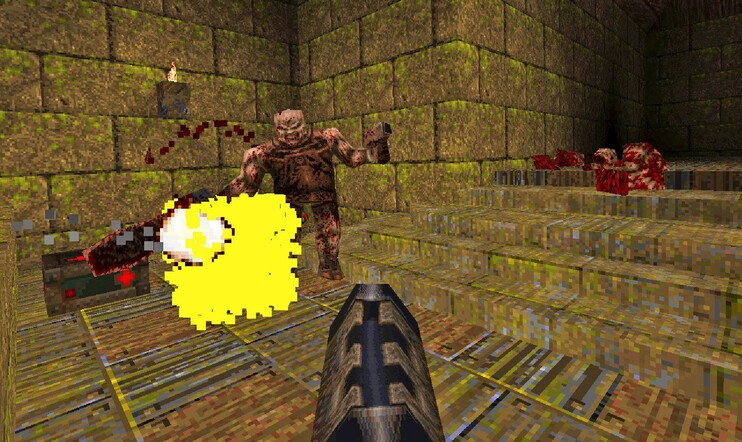
Quake 1996 screenshot
The sound cards and their audio processing qualities continued a steady pace of improvement throughout the 1990s. The built-in DSP effects like reverb became quite common, and the use of different forms of synthesis as well. The cards also had memory slots that allowed the import of custom sounds. Also, iMuse in 1991 changed the game, especially for game composers. The system allowed the music to adapt to the players' choices and was first experienced in the LucasArts game Monkey Island 2: LeChuck's Revenge (see my previous article for details about adaptive music). Other games using the iMuse include Grim Fandango (1998) and Day of the Tentacle (1993).
Games on the net and phones
When PCs have experienced an ongoing evolution in their CPU power and storage capacities, the games could also have more DSP effects inbuilt. The developments on the internet since the mid-1990s also allowed the games to move to the web partially. Because many browsers could not deliver playback audio, there had to be several plugins to aid the delivery. These were, for example, Flash, Shockwave, and Beatnik. They invented the term casual games to help classify internet-based games. It indicated those games that one would only play for short periods because of memory limitations. These were, for example, puzzles. Another term coined by the advertisers was advergames, which promoted certain products. We can find examples in titles like Farmville and physical game releases like Chex Quest and Pepsiman.
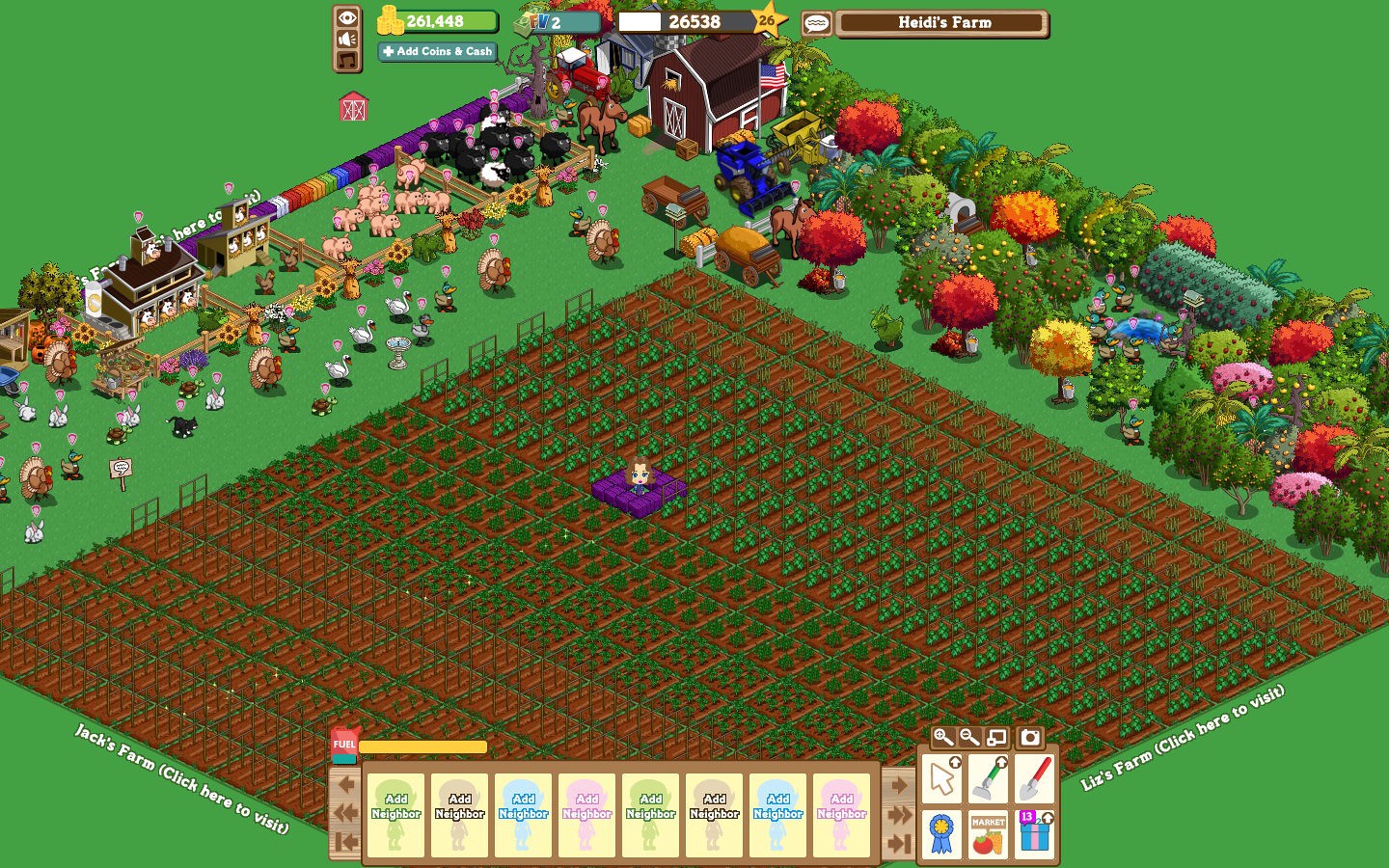
Farmville screenshot
Cell phones started to get their games in the early 1990s. Who would not have played the Snake on the old Nokia phones or other platforms? They launched this legendary game in 1997 on the Nokia 6110. Its origins were in an arcade classic called Blockade from 1976. The limited memory space of cell phones allowed composers to use MIDI for the compositions and sound effects. When the iPhone arrived in 2008, it was one of the first cell phones to process audio with higher quality and offer more computing power. There were a dozen or more voices in use, and it could stream audio from the phone's memory. When the iPhone and iOS App Store opened in 2007, also game developers could display their products for a wider audience. Games were primarily casual because there were still restrictions in the memory and other factors. The early success stories in this category included Angry Birds (2009) and Cut the Rope (2010). The first one's soundtrack was composed by Ari Pulkkinen, and the second one's by Andrew Burmistrov, Ruslan Shakikov, and Michael Chertichev.
The rise of audio middleware and cloud computing
When the programmers start to code the game, there are tool packages and software libraries, making the coordination a bit easier. The libraries are also called APIs or application programming interfaces. The tools help the developers who don't have a heavy programming background in integrating assets, level building, and testing an array of elements inside the game. Software libraries made for 3D games are, for example, UDK, Unity3d, and Source. Middleware is the collection of these tools and software libraries. These aid in developing high-end audible results and work as an easy-use tool for audio professionals. The middleware packages for audio help the composers and sound designers simplify the integration and processing of the audio in many cases without the need to consult the programmers. They also make the delivery of the sounds easier for several platforms and formats.
One of the essential middleware packages is undoubtedly the Miles Sound System. A programmer called John Miles developed it in 1991. He wanted to unify the delivery of the sound files for all of the sound cards that were available at the time. It was a problem because all of the sound cards had a specific implementation of sound, and the programmers had to program for many of them simultaneously. All sound cards sounded different as well. Miles built a collection of sounds in different instrument categories using FM synthesis cards to standardize the array of sounds that would play. It resulted in all of the sound cards eventually beginning to sound similar no matter what the sound was. Later additions in the processing are playback, DSP, mixing, audio decompression, and embedded instruments.
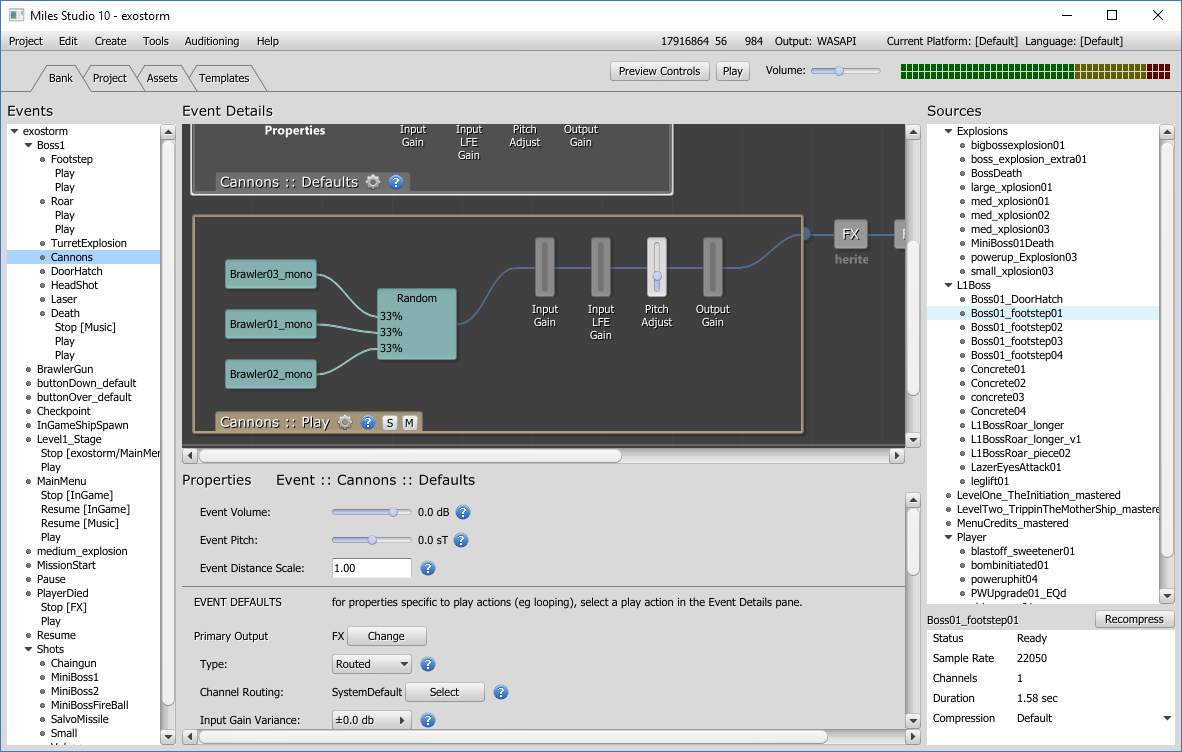
Miles Sound System - Miles Studio 10
Many game developers have also produced publisher tools that help the game development process with ease in mind. Audio devices like DirectMusic by Microsoft and its follower the XACT in 2002, the composers and sound designers had access to tools like randomizing sound files, pitch, filter and volume data, and layering, looping, and comprehensive DSP effect options. It was in use on the Xbox, whereas DirectMusic operated on Windows. Sony also created its tool called SCREAM. Also, game companies like Bethesda, Ubisoft, and EA made their audio tool kits. Because there are no standards in the industry for audio implementation, the use and development of middleware have continued until modern times. The most popular packages include Wwise,Fmod,Tazman's Fabric 2, ADX2, and Unreal 5. RUMR (real-time user remix) can do Real-time DSP remixing. When games have become downloadable from platforms like Steam, the developers can offer additional music on expansion packs that one can buy separately. It is how the games have started to expand past their boundaries when they no longer require a physical disk. When you can use a powerful computer based on a cloud server, it will be less critical to have a home computer with good specs when it's a mere medium in the equation.
Summary
The repetitiveness of the game music in the pioneering systems was mainly due to the limited memory and sound processing capabilities that they had on board and the amount of time in use for the composing. Some games of those early years astonished how they could fit such intricate soundtracks in the allowed memory space. Composing was also a matter of handicraft, when each note value, volume, and pitch would be on a line of code language. The composers had to work with strict and busy time limits because even the hit games didn't have a long lifespan. It was due to the increasing competition when everybody wanted their titles to reach the top shelves. The PSGs found in many consoles did not allow, for example, changes in the timbres of the instruments, so they were pretty limited in expression.
With the evolving technology, especially the memory capacities, sound chips, sound cards, and FM synthesis, it became gradually possible to make increasingly complex soundtracks to games. The restrictions fueled the innovations in a similar way that they did on the console gaming side. In many cases, the computers offered more processing power for the audio, only then when many computer companies developed their dedicated sound chips for the systems.
Also, on the FM synthesis side, computer systems like Sharp X68000 were far more advanced in sound delivery quality than the consoles of that time. They mainly did not save in the production costs, even on the audio components, as many console companies did. The arrival of sophisticated sound cards in the early 1990s meant that the hardware allowed the usage of true CD-quality sound. General MIDI access and the possibility of bringing their high-quality sound files started becoming more like a factory standard for the trade. MIDI was replaced by CD-ROMs when the games did not need the sound processing qualities of the sound cards to produce the sounds. In modern computers, the early technological restrictions do not exist anymore. The composer has an array of possibilities for creating the soundtrack, especially when thinking of its expressivity. There are still limitations, but they can, for example, record a symphony orchestra in a concert hall, and the composers can use professional musicians with decades of experience under their belt. The composer can customize each instrument or instrument group by how they play. It enables the capturing of different moods more precisely.
When programmers have simplified the game development process by coding middleware and publisher tool packages, it has allowed non-programmers to jump on the bandwagon. Composers and sound designers have a designed set of tools in use, making the delivery of soundtracks and sound effects much easier than in the early years. The relative ease that the software allows has enabled a more convenient way to distribute ideas. The audio professionals can concentrate most of their brainpower on the creative process rather than sweating over sound implementation issues. Computer specifications are becoming more and more obsolete when gaming is gradually moving to the internet. Cloud computers that work on servers like Steam will have far more processing power than our home units, and the upcoming age will offer a lot for online gamers.
References
A Challenger for the Sound Card Crown: The Pro Audio Spectrum 16. Retrieved from
http://nerdlypleasures.blogspot.com/2017/01/a-challenger-for-sound-card-crown-pro.html.
Advergame. Retrieved from https://en.wikipedia.org/wiki/Advergame.
Amiga. Retrieved from https://en.wikipedia.org/wiki/Amiga.
Amiga in Japan. Retrieved from https://amitopia.com/interview-shinji-amiga-in-japan/.
CD-ROM. Retrieved from https://en.wikipedia.org/wiki/CD-ROM.
Collins, Karen. (2017). From Pac-Man to Pop Music: Interactive Audio in Games and New Media. Routledge: London.
Commodore 64. Retrieved from https://en.wikipedia.org/wiki/Commodore_64.
Glancey, P. (1996). The Complete History of Computer and Video Games. Computer and Video Games.
List of game middleware. Retrieved from https://en.wikipedia.org/wiki/List_of_game_middleware.
MOD (file format). Retrieved from https://en.wikipedia.org/wiki/MOD_(file_format).
Paris, David & Paris, Stephanie Herweck. History of Video Games. Teacher Created Materials: Huntington Beach, CA.
PC-8000 series. Retrieved from https://en.wikipedia.org/wiki/PC-8000_series.
Robert Yannes. Retrieved from https://en.wikipedia.org/wiki/Robert_Yannes.
Sharp X68000. Retrieved from https://en.wikipedia.org/wiki/X68000.
Sweet, Michael. Writing Interactive Music for Video Games: A Composer's Guide. Addison-Wesley: Upper Saddle River, NJ.
The 1983 Home Computer Price War. Retrieved from https://lowendmac.com/2016/the-1983-home-computer-price-war/.
The Pro Audio Spectrum Frequently Asked Questions List: Version 1.1. (October 1992). Retrieved from http://files.mpoli.fi/unpacked/hardware/sound/pas/pasutl20.zip/pas-faql.txt.
Images
Picture 1. Apple II. https://upload.wikimedia.org/wikipedia/commons/9/98/Apple_II_typical_configuration_1977.png
Picture 2. Sinclair ZX Spectrum advertisement. www.nostalgianerd.com/wp-content/uploads/2015/06/specadvert.jpg.
Picture 3. The Great Giana Sisters cover art. https://www.c64-wiki.com/images/4/48/Gianas_Sisters_Cover_Disk.jpg.
Picture 4. MOS 6502 AD Chip. https://upload.wikimedia.org/wikipedia/commons/4/49/MOS_6502AD_4585_top.jpg.
Picture 5. Sharp X68000 user manual illustration. https://nfggames.com/grafx/scans/X68000%20Room.jpg.
Picture 6. Quake 1996 screenshot. https://pelaaja.fi/sites/default/files/kuvat_artikkeli/quake1996_0_0.jpg.
Picture 7. Farmville screenshot. https://miro.medium.com/max/1838/1*hWx3NHhMtqDjXeT_tpVcqg.jpeg.
Picture 8. Miles Sound System - Miles Studio 10. http://www.radgametools.com/images/miles_ss2.png.


